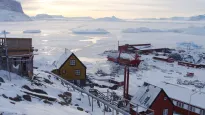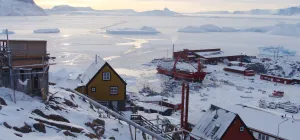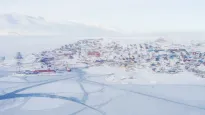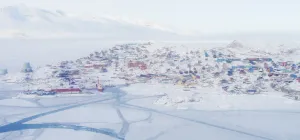Iceberg calves off of King Baudouin Ice Shelf

Around the time the Princess Elisabeth station crew were unloading the Mary Arctica, a 70 km2 iceberg calved off of the King Baudouin Ice Shelf, just 40 km away from Breid Bay.
I spy with my satellite eye
Over the past weekend International Polar Foundation Vice-President Nighat Amin spotted an interesting event: on January 25th, it appears that a 70 km2 iceberg broke away from the end of the King Bauduoin Ice Shelf - only 40 km to the east of Breid Bay, where the station crew had been unloading the Mary Arctica around the same time.
According to Université Libre de Bruxelles (ULB) glaciologist Frank Pattyn, who has been studying the King Baudouin Ice Shelf for several years, and was on the ice shelf with a team of fellow glaciologists from the ULB this past November and December, the 12 kilometre-long and 6 kilometre-wide iceberg may have already started to break away from the ice shelf before January 25th, and only started to drift away on that particular day. Satellite imagery from the end of 2014 shows a large fissure in the ice shelf where the iceberg eventually broke off.
Calving is natural
The calving of icebergs (the process by which ice breaks away from the end of an ice shelf or glacier) is a natural phenomenon whereby ice flowing off of a continental ice sheet (such as those in Antarctica and Greenland) is lost to the ocean. An ice shelf is a floating platform of ice that is an extension of ice flowing off of the continental ice sheet out towards the ocean. Ice periodically calves off the seaward end of an ice shelf and is replaced by ice flowing off from the continent behind it.
The King Bauouin Ice Shelf hasn’t shed ice since the 1960s, according to Pattyn, so the calving event has been a rare event to witness. “We’ve been studying this ice shelf for so long,” Pattyn remarked. “so it’s interesting to finally see something happen!”
While the King Baudouin Ice Shelf doesn’t lose ice very often, the fact that it has recently isn’t a sign that the ice shelf is weakening or in iminent danger of collapse. Pattyn explained that an ice shelf can only grow so far - up to the continental shelf break on the coast of Antarctica, where the sea floor dramatically drops - before part of it inevitably calves off. “It is very difficult for an ice shelf to grow beyond that limit,” explained Pattyn.
Pattyn’s colleague at the ULB, glaciologist Reinhard Drews (a past laureate of the InBev-Baillet Latour Antarctica Fellowship), also added that according to the data they have, the velocity at which the ice in the ice shelf has been flowing towards the ocean hasn't increased dramatically over the past several decades. This is in stark contrast to the dramatic increase in ice flow velocity seen in places like Pine Island Glacier in West Antarctica, which is rapidly losing ice to the ocean. Whether the King Baudouin Ice Shelf remains stable in the coming decades, however, will depend on whether climate warming starts to affect the part of East Antarctica where it sits, according to Drews.
I want to break free
It’s impossible to know exactly what caused the iceberg to break free. The Princess Elisabeth station crew who had taken part in the unloading at the coast hypothesized that the swell caused by a storm that disrupted the unloading of the Mary Arctica might have been what dislodged the iceberg from the ice shelf. Drews commented that the swell could be behind the dislodging of the iceberg. However he explained that there is “no way of knowing for sure” that the swell is what finally caused it to break free.
Whatever provoked it to go, Pattyn said that he was happy not to have been on the part of the ice shelf that broke off. The GPS stations he and his colleagues set up on the ice shelf for the IceCon project are now much closer to the sea than they were a few weeks ago!
Download





















